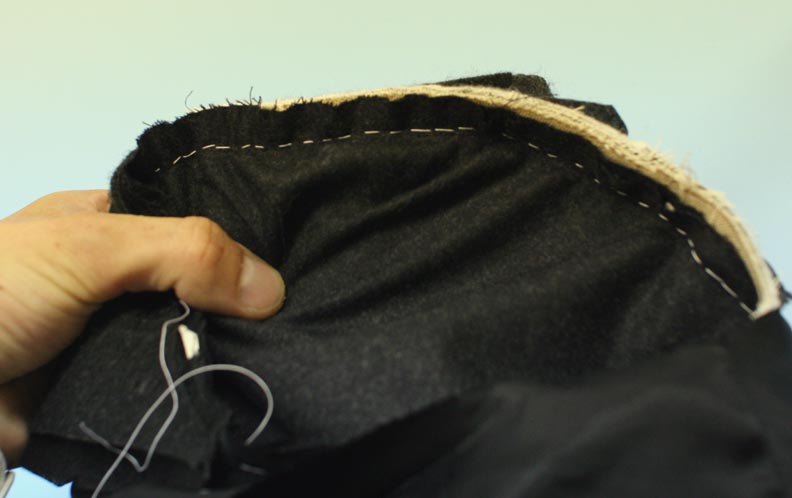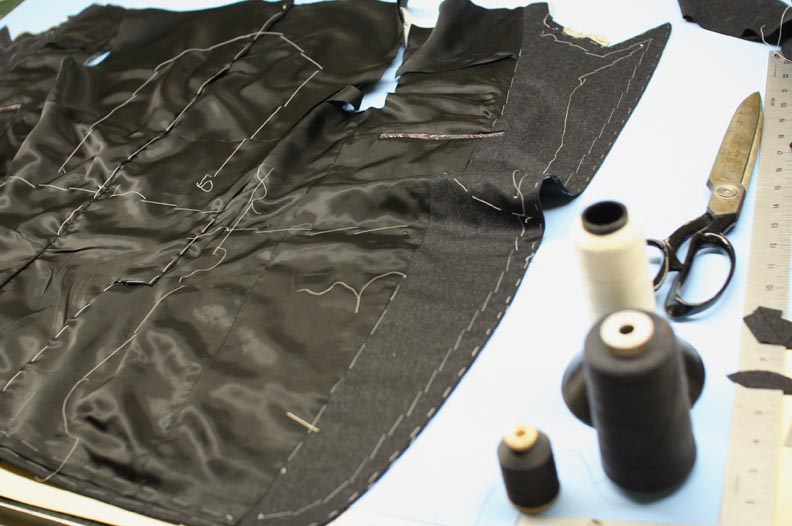One thing that is easy to spot is a hand-finished lining. The little stitches are fairly uneven and poke through the edge of one side of the seam which has been lapped over the other. There are several reasons to do this, and a multitude of different areas it may be done.
The most common area felled by hand is the armhole. Have you ever inserted your arm into a sleeve and the lining twisted or bunched or caught on something and you felt caught in your sleeve? Tailors don't like having stuff like linings and facings just floating loose, twisting one way while the jacket goes another. So the seam allowances of the lining on better jackets are basted (sewed) to the seam allowances of the sleeve- they now act as one unit and won't twist, or worse, hang out the bottom. Having attached these two means that we can no longer get inside the sleeve to close the armhole by machine, so it is closed by hand. But even more important than that, stitching through multiple layers make things firmer. More stitches make things more firmer. This principle is used during padstitching to add more or less firmness and structure. Machine stitching through many layers becomes stiff and hard. Stitching through the armhole to close the lining by machine, you are sewing through the jacket, sleeve, many layers of canvas and the canvas and felt in the sleeve head. Even the loose stitches used on special machines to do just this don't do a great job, and can also compress these layers which affects the shoulder expression. Sewing it all up by hand you get none of the stiffness associated with machine-felling. Two very good reasons to close by hand.
Before we even get close to the sleeve, though, better garments have been tacked together in a similar fashion to the sleeve. More affordable garments have a facing and lining which is all assembled together in one piece- it is joined to the jacket at the front edge, along the hem and the bottom of the sleeves, and the whole is turned right side out through a hole in the sleeve lining, which is then sewn shut from the right side; this is a process called bagging. It is quick but everything is hanging loose- it's like wearing two garments which don't necessarily move together. A better garment, however, will have the facing attached to the front edge, then basted in place- the inside edge of the facing is then tacked into the canvas so it won't move. Some factory-made garments will also be tacked a small amount at the side seam, but often the facing is the only one to be tacked.
There is also the issue of engineering a lining or not. There is a lot of shifting and manipulation in the process of tailoring. Better garments are usually cut bigger than required, like at the lapel, so that after the padstitching which makes things move around a bit, the lapel is later trimmed to shape. This kind of shaping and trimming goes on throughout the process so you end up with the perfect fitting garment. It is very difficult to predict how fabric will move and shrink during production and if there is no allowance for this you can end up with a garment which does not fit quite as perfectly a it should. A bagged lining assumes that the fabric will react exactly as you think it will (it never does) and so many factories struggle with alining that is too long for once fabric and too short for another, or for tight or twisted linings which pull at vents and sleeves. Not pretty. So back to the bespoke lining. The lining of a bespoke garment will be cut much bigger than the cloth so that as the fittings progress and the garment takes shape, we can trim down the lining to fit, basting it into place, and a we work across the garment, from the tacked facing edge, we can then tack the side seam all the way, the back seams, then the shoulder seams which are sewn to the shoulder pad before felling...... Every single seam has been tacked to the canvas or the cloth of the shoulder pad. Nothing is left floating freely and once we have built the shape, it is there pretty much permanently. All these tacked seams prevent us from closing up from the inside so all the lining seams are felled by hand. This is definitely one of those operations, in my opinion, in which the hand-sewn method wins, pardon the pun, hands down.








0 comments:
Post a Comment